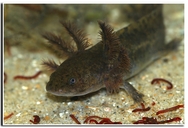|
Ambystoma andersoni Krebs & Brandon, 1984
Achoque (local Mexican name), Anderson’s salamander Subgenus: Heterotriton | family: Ambystomatidae genus: Ambystoma |
| Species Description: Krebs, S. L., and Brandon, R. A. (1984). A new species of salamander (family Ambystomatidae) from Michoacan, Mexico. Herpetologica 40, 238–245. | |
 © 2008 Henk Wallays (1 of 15) |
|
|
|
Description Similar species include A. dumerilii, which also has short, highly webbed toes and 14 – 25 gill rackers, but A. andersoni is reddish-brown with spotting while A. dumerilii is uniformly brown with no markings. The two species also differ in A. dumerilii having hyperfilamentous gills, a smaller eye, smaller eggs, and larger body size at sexual maturity (Krebs and Brandon 1984).
In life, the body is reddish-brown marked with black dots that are sometimes interconnected, The dorsal coloring is reddish-brown even in preservative (Krebs and Brandon 1984).
Distribution and Habitat Country distribution from AmphibiaWeb's database: Mexico
Life History, Abundance, Activity, and Special Behaviors Though this species is not believed to be rare, Ambystoma andersoni has only been found in one location and pollution of its habitat and predatory fish have contributed to a decreasing population trend. Ambystoma andersoni are known to eat snail and crawfish (Shaffer et al. 2004).
Trends and Threats Relation to Humans Possible reasons for amphibian decline General habitat alteration and loss Comments The species epithet, "andersoni," is in honor of James D. Anderson, who is an American herpetologist that first recognized the distinctiveness of this species (Tighe 2023).
References
Krebs, S.L. and Brandon, R.A. 1984. A new species of salamander (Family Ambystomatidae) from Michoacan, Mexico. Herpetologica: 238-245 Shaffer, H.B, Flores-Villela, O., Parra-Olea, G., Wake, D. 2004. Ambystoma andersoni. In: IUCN 2012. IUCN Red List of Threatened Species. Version 2012.2. Tighe, K.A. (2023). Catalog of type specimens of recent Caudata and Gymnophiona in the National Museum of Natural History, Smithsonian Institution. Smithsonian Contributions to Zoology 654.
Species Account Citation: AmphibiaWeb 2023 Ambystoma andersoni: Achoque (local Mexican name) <https://amphibiaweb.org/species/3824> University of California, Berkeley, CA, USA. Accessed Jun 16, 2025.
Citation: AmphibiaWeb. 2025. <https://amphibiaweb.org> University of California, Berkeley, CA, USA. Accessed 16 Jun 2025.
AmphibiaWeb's policy on data use.
|



 Raffaëlli Account
Raffaëlli Account Map of Life
Map of Life